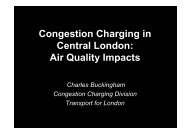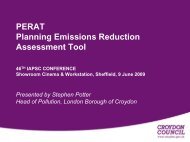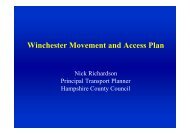Cars and behaviour: psychological barriers to car restraint ... - iapsc
Cars and behaviour: psychological barriers to car restraint ... - iapsc
Cars and behaviour: psychological barriers to car restraint ... - iapsc
You also want an ePaper? Increase the reach of your titles
YUMPU automatically turns print PDFs into web optimized ePapers that Google loves.
Au<strong>to</strong>bahns without a general speed limit, are twice as unsafe as the Dutch highways with a<br />
mixed speed limit system of 100/120 km/hour.<br />
The above shows that there is a significant causal relationship between fuel consumption, CO2<br />
emissions <strong>and</strong> emissions of NOx, CO <strong>and</strong> CxHy on the one h<strong>and</strong> <strong>and</strong> vehicle design features such as<br />
weight, specific power, performance, <strong>and</strong> <strong>behaviour</strong> patterns (speed <strong>and</strong> acceleration) on the other.<br />
TNO Mo<strong>to</strong>r Vehicles Test Lab concludes that optimum speed, with the lowest emissions <strong>and</strong> fuel<br />
consumption, is between 60 <strong>and</strong> 80 km/hour for goods vehicles <strong>and</strong> between 70 <strong>and</strong> 90 km/hour for<br />
private <strong>car</strong>s. Thus, reducing the power <strong>and</strong> speed of vehicles is highly effective in attaining<br />
environmental as well as road safety goals.<br />
Road safety: the hidden power< >risk paradox<br />
In the USA a fierce battle has been going on concerning the (assumed) lack of safety of small <strong>and</strong> fuel<br />
efficient <strong>car</strong>s in connection with the possibility of achieving further energy savings by means of body<br />
downsizing [4]. As regards passive safety, there is indeed a general statistical connection between<br />
vehicle weight <strong>and</strong> risk. But accident statistics do not prove that large, heavy <strong>car</strong>s are intrinsically safe.<br />
Collision tests <strong>and</strong> statistics from, inter alia, the US Highway Loss Data Institute (HLDI) <strong>and</strong> the<br />
Swedish Folksam [5] prove that in practice it is not weight or size that determines risk, but the quality<br />
of the safety structures <strong>and</strong>, above all, the vehicle's "character" in terms of (<strong>to</strong>o much) power,<br />
performance, roadholding <strong>and</strong> "macho" image. Vehicles in the same weight class perform very<br />
differently in both collision tests <strong>and</strong> accident statistics. In German statistics the highest risks occur not<br />
only in the structurily unsafe category of very small <strong>car</strong>s (minis) designed in the 50s <strong>and</strong> 60s, but also<br />
in the category of the latest fast sports <strong>car</strong>s, with twice the weight, such as the Audi Quattro <strong>and</strong> BMW<br />
M3.<br />
What is the reason for this?<br />
The active safety of private <strong>car</strong>s has increased significantly in recent decades thanks <strong>to</strong> improvements<br />
in vehicle design. In this connection, a paradoxical phenomenon, which can be explained in terms of<br />
compensa<strong>to</strong>ry <strong>behaviour</strong>, occurs: the so-called "ABS effect". German experiments revealed that,<br />
contrary <strong>to</strong> expectations, a disproportionate number of <strong>car</strong>s with an anti-blocking system were involved<br />
in accidents. Apparently, the perception of extra safety removes inhibitions characteristic of a safe,<br />
defensive driving style. Available insurance statistics [5] show that <strong>car</strong>s with perfect road-holding <strong>and</strong> a<br />
high power rating are involved in accidents <strong>to</strong> a disproportionate degree, especially sports <strong>car</strong>s <strong>and</strong><br />
Mercedes, BMW <strong>and</strong> SAAB models, which achieve high scores for both active <strong>and</strong> passive safety. In<br />
the USA, the two-door (first generation) SAAB 900 - usually a Turbo - has been found <strong>to</strong> be three<br />
times as unsafe for its drivers as the four-door model, whereas the passive safety of both is the same.<br />
In conjunction with specific driver characteristics such as age (young) <strong>and</strong> sex (male), this aspect<br />
resulted in recorded risk variations in the USA of up <strong>to</strong> 800% within the same weight category (see<br />
table 2).<br />
The obvious conclusion is that, in the case of fast <strong>car</strong>s, design features (such as character,<br />
performance, perfect active safety features, airbags <strong>and</strong> sophisticated crash testing) in conjunction<br />
with <strong>psychological</strong> fac<strong>to</strong>rs, such as overestimation of one's own abilities <strong>and</strong> risk compensation, lead<br />
<strong>to</strong> a high level of active unsafety. Since the new <strong>car</strong> fleet average <strong>to</strong>p speed is now up <strong>to</strong> 190 km/hour,<br />
this phenomenon is true for all <strong>car</strong>s except real minis.<br />
Indeed, some <strong>car</strong>s must be regarded as "killers", especially large <strong>and</strong> heavy <strong>car</strong>s (such as 4WD <strong>and</strong><br />
pick-ups) <strong>and</strong> “muscle <strong>car</strong>s”. Taking in<strong>to</strong> account the not moni<strong>to</strong>red fate of “collision partners”, any<br />
<strong>car</strong>’s risk profile should include accident frequency <strong>and</strong> active unsafety as well as risk <strong>and</strong> crash test<br />
figures. Furthermore it must be noticed that specific <strong>car</strong> model risk statistics vary considerably over<br />
time <strong>and</strong> place. For exemple, the Volvo 240 or Mercedes 200 series perform less well in Australian<br />
risk ratings than in the US ratings.<br />
It is therefore disappointing that HLDI <strong>and</strong> the US Insurance Institute for Highway Safety completely<br />
ignore these hidden risk fac<strong>to</strong>rs <strong>and</strong> wrongly proclaim vehicle size <strong>to</strong> be the best safety guarantee<br />
("buy big").<br />
Table 2 Accident risk within size classes.










